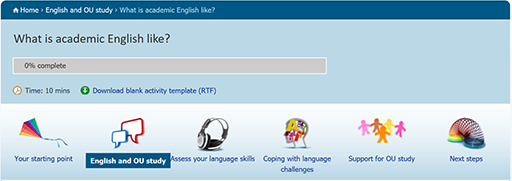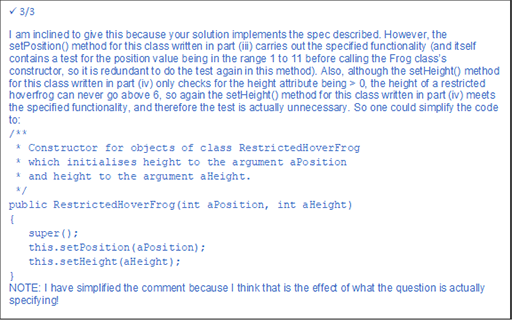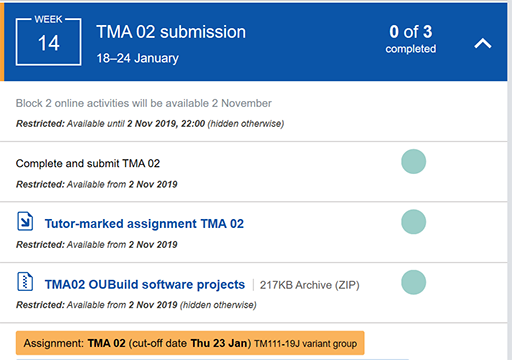Use 'Print preview' to check the number of pages and printer settings.
Print functionality varies between browsers.
Printable page generated Sunday, 28 April 2024, 10:49 AM
Part 5 Correspondence tuition
5.1 Introduction
This part of the course helps you to understand the significance of the tutor role in providing excellent correspondence tuition.
We also learn about processes to manage the marking of tutor-marked assignments (TMAs) via the electronic tutor-marked assignment (eTMA) system.
In addition, it helps you understand how student work is graded in accordance with the module guidelines and to see how to encourage student progress through appropriate feedback.
5.2 Role of the tutor in supplying tuition and feedback.
Correspondence tuition is an extremely important aspect of the tutor role and a really good way to develop a personalised approach to support students.
For many students, the comments that tutors put on their marked assignments are the only direct, personal tuition they receive so it is important that the comments added are both supportive and effective. It is an opportunity to be encouraging regarding the work students have submitted and can also be a driving force for student learning.
The feedback given can help to open up a dialogue between tutors and the students they support. Tutors can provide clear advice relating to students’ skills and knowledge development, for example by highlighting how their study relates to specific learning outcomes. As well as providing feedback on the work submitted, it is an opportunity to be forward-looking, to help students improve in future assignments.
It is also an opportunity to help students pace their studies by highlighting the key milestone and upcoming tutorials, for example.
Activity 1 
Watch this video where students Heather Bloomer and Cath Brown give an insight into how they regard tutors at the OU.
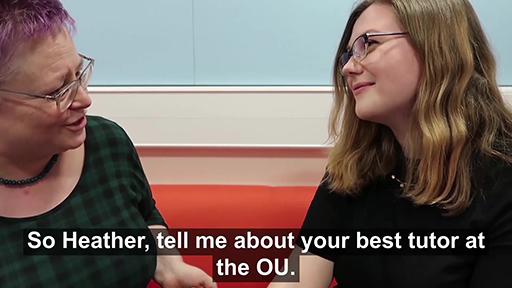
Transcript
After watching the video think about the possible ways of building good tutor–student relationships via correspondence tuition. What kinds of methods could be tried?
5.3 The marking process
This section gives an insight into how tutors might approach the marking of TMAs.
We start by outlining the eTMA system, and how this is central to the marking process. We then explain about the significance of module marking guides in providing support and guidance for tutors and give some examples of how feedback might be added when marking students’ work.
Finally, there is a brief outline of how the university ensures consistency of marking across the modules.
5.3.1 The eTMA system
When the OU was founded over 50 years ago TMAs were submitted in hard copy, usually handwritten and posted to the tutor. This started to change around the year 2000 with the introduction of the eTMA system, and now most assignments are submitted via the eTMA system.
Students produce their assignments on a computer, an eTMA, and submit it electronically. Nowadays the term TMA is commonly used for both types of assignment, whether submitted via hard copy or the eTMA system.
The following diagram outlines the journey of an eTMA.
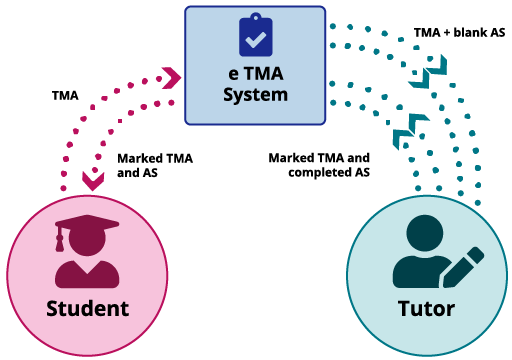
A key point to note from a tutor perspective is that most of the administration tasks are handled by the eTMA system, so tutors can focus on the marking and feedback. It is useful to check the file formats as the TMAs arrive, as some student need support using the eTMA system. This quote from an experienced tutor highlights how he makes an early check on eTMA submissions.
"Before attempting any marking of further solution documents, I check for the correct format and inclusion of relevant files. If there are submission errors, then my current module requires that the student be informed and given the opportunity to resubmit. I would do this by email explaining the error(s) made whilst also providing appropriate help and support. I also give a time limit for that resubmission." (Geoff, from the Correspondence tuition workbook)
You can download the Correspondence tuition workbook (CTW) as an additional resource for more information.
5.3.2 Marking guides
For each assignment, the module team produces a marking guide. Marking guides are helpful in ensuring consistency of marking across the tutors on the module. As the following quote demonstrates, the marking guides can also help when responding to TMA queries.
"As I was new to tutoring M269 (Algorithms, data structures and computability), I worked my way through the module material before attempting each of the TMAs as if I was a student. That helped me to understand the pitfalls that the students would come across.
"After attempting a TMA, I then turned to the Marking Guide and marked my own work as if I were marking that of a student. Again, this gave me a deeper insight into issues with the interaction between the questions and the Marking Guide and I could raise any of my confusion on the tutors’ forum well in advance of the marking period." (Shena, from the Correspondence tuition workbook)
It is important to note that some module teams also produce specimen answers. These may be added to a student’s script, in addition to tutors’ own comments, but should not be a replacement for personalised feedback.
5.3.3 Adding feedback to TMAs – the practicalities
The time it takes to mark a TMA can vary enormously due to the range of possible TMA questions, and how well the students answer questions. Tutors employ a variety of marking strategies, for example by building a useful bank of feedback comments, which might help with the efficiency and consistency of marking.
"I maintain a separate comments document for a TMA and make notes about useful sections of module material or figures or other sources, which might be relevant to help weaker students and those who need to be challenged. As the marking progresses, I build up a bank of reusable comments for each TMA question." (Joan, from the Correspondence tuition workbook)
How tutors approach the marking can also vary across the different Faculties and Schools at the OU. A key thing to bear in mind is that tutors have flexibility when marking, as highlighted in the following quote.
"I set myself a target number of scripts to mark each day. If the scripts are good then it is usually easy to achieve the target in a day, but the marking will take longer if the scripts are from weaker students. Allowing some contingency in your schedule is a good idea!" (Joan, from the Correspondence tuition workbook)
Equally important is for tutors to make sure that students can view the marking comments. For this reason, many tutors add comments directly to the students’ scripts, in a contrasting colour. Tutors might also use Track Changes or other marking methods.
Whatever marking method is used, tutors should check with students that they can view the marking comments. This might be achieved via a dummy TMA that students are encouraged to complete at module start, also known as eTMA00.
"I use eTMA00 to ask the student to comment on how my feedback works for them and I would change it if requested." (Shena, from the Correspondence tuition workbook)
In this way, tutors can be sure right from module start that the feedback they provide is in the most suitable format for students.
5.3.4 Coordination and monitoring of marked assignments
Tutors might be asked to engage in a coordination activity with fellow tutors on a module prior to marking a batch of TMAs. This is to help ensure that all tutors are marking the TMAs in the same kind of way and is also an opportunity for everyone to check that the marking guide is clear.
When marking, tutors also have access to a tutor forum so there is always a friendly place to go to ask for advice whenever needed.
Activity 2 
What are the main issues you foresee in marking at a distance?
Post your thoughts to the discussion forum and comment on some other posts. Do you agree with the other posters?
A tutor’s marking is regularly monitored at the OU. This serves two purposes, as monitors comment on the grading of scripts, and the appropriateness of feedback to the students. Monitors are fellow tutors, so this is peer feedback and provides opportunities for dialogue and support between tutors.
5.4 Skills of providing feedback
In this section, we look at possible marking approaches in a little more detail. Tutors naturally have individual styles of commenting, so there are no hard-and-fast rules for good correspondence tuition. Whatever type of feedback is included, it is important to bear in mind that the tone can provide much more motivation for the student if it is expressed in a positive way.
Students often spend a significant amount of time on their assignments and have a good sense of achievement when they submit it. Marking comments should therefore be encouraging, even if the student has dropped marks on the assignment.
In her work on a major OU research project into correspondence tuition, Mirabelle Walker (Walker, 2009) investigated student responses to different types of feedback received via comments on their TMAs.
Her findings in An investigation into written comments on assignments: do students find them usable? help to give a feel for the kind of comments that students find most useful.
In particular, Walker discovered that:
"...students appreciate motivating comments; the most effective comments for the student’s future work are those that relate to skills development; the most effective comments for helping students to understand inadequacies in their work are those that are designed to help the student bridge the gap between their current knowledge, understanding and skills and those expected of them."
Looking in a little more detail, an analysis of the tutor comments she reviewed revealed that they could be categorised into three types:
Depth 1 comments indicate a problem.
- ‘More needed here’ (a comment relating to content)
- ‘Poor structure’ (a comment addressing a skill) are of this type.
Depth 2 comments correct a problem.
- ‘You should have included something about the actual data rates’
- ‘Your answer would have had a better structure if you had started with an introductory paragraph and also used shorter paragraphs throughout’ are of this type, as is the insertion of the right answer alongside/after an incorrect one.'
Depth 3 comments not only correct a problem but also go on to explain why. The depth 2 comments above would become depth 3 as follows:
- ‘You should have included something about the actual data rates here because ...’
- ‘Your answer would have had a better structure if you had started with an introductory paragraph and also used shorter paragraphs throughout. This is because…'
The research showed that the depth 3 comments can help students understand their feedback, so can be very effective in building a ‘bridge’ between where the student is now and where they need to be.
Often, the students who struggle don’t attend tutorials and their written work is the only opportunity tutors have for providing encouragement. How successful this is may well influence a student’s decision as to whether to continue with the module.
Activity 3 
Take a few minutes to reflect on when you have been on the receiving end of written feedback in any context.
How have you felt, what has been useful and what less so?
Does the language used make a difference to how you feel about the feedback?
Post your thoughts to the discussion forum and comment on some other posts. Do you agree with the other posters?
In the following example, which asks the student to write part of a computer program, the tutor has enclosed part of a model solution and shown the student how and why the correct approach works.
Student's attempt
How many Boxes
boxes output: No discount
false
boxes >4 5% discount
false
boxes >12 10% discount
false
>= expression (>=30) -----------> 20% discount
Tutor's response
"This is a good attempt, but the question wanted you to produce something with more detail that was closer to the example I have added here. As you can see it shows the ‘if’ statements and the indentation – indentation might seem unnecessary, but as you develop your programming skills it will help you to read code and to find errors more easily. The sample solution that I have added below shows the level of detail:
if (the number of boxes is 3 or fewer)
inform the customer that they are not entitled to a discount
else
if (the number of boxes is 11 or fewer)
inform the customer that the volume discount is 5%
else
if (the number of boxes is 30 or fewer)
inform the customer that the volume discount is 10%
else
inform the customer that the volume discount is 20%."
In the example above, the student is praised for what they have done, then given further advice and a sample solution. This gives a good sense of dialogue as if the student was sitting next to the tutor having a conversation.
Tutors also often have students whose work is very good and may think there’s not much to add except tick their answers and give some words of praise. However, these students also need an appreciation of their efforts, and perhaps there are places where they can be stimulated to engage in further enquiry.
Some modules have especially challenging problems to attempt, for example, some students may respond eagerly to the idea that they are capable of tackling them. On the assignment, a hint or a question may lead such students in new directions.
One way to stretch a good student is to suggest an alternative answer, as shown in the following example.
Student's attempt
"For the library keywords, I chose to use strings, with a minimum of three characters, and a maximum of 30. I feel this represented a good balance between user freedom and practicality. Hopefully, a three-character minimum will capture typographical errors.
"A 30-character maximum should be sufficient, although pictures related to Pneumonoultramicroscopicsilicovolcanoconiosis may cause problems. 30 characters also allow users to use small groups of words as keywords. The alternative was to provide one large string area for multiple keywords. This system is unsatisfactory as it would require the user to separate the keywords with commas or other punctuation."
Tutor's response
"Well, a fair argument but the case where there are more than 30 characters can’t really be ruled out.
"An alternative is to argue that keywords will most likely be passed to a search engine that accepts a single string, so there is no need to provide any greater structure here – a simple string for the whole sequence of keywords is sufficient."
On a more general note, if a question has not been attempted at all, then it is a good idea to try to find out if the student didn’t find the time, didn’t understand what to do, or has lost the confidence to even try. In this way, appropriate support can be provided.
5.5 Feedback and feedforward
The comments added to a marked script tend to feedback to the student regarding what was correct and where they lost marks. As well as marking the student’s script, tutors also complete a summary form for each student. The summary form can be used to summarise the feedback on a script but can also effectively be used to feed forward.
The summary form complements the feedback given on a script and can be used to add more general study points and advice. When marking, it is recommended to check any previous summary forms and then to refer back to previous advice where relevant.
It is important to be positive in comments on the summary form as students receive their TMAs back in electronic form and can choose which file to open first. We don’t want them to be deterred from even looking at the marked script after reading the assessment summary form. It is a good idea to praise effort, rather than the actual assignment score.
This summary form example is encouraging and supportive, and ends on a positive note:
"Hi,
Well done for getting through TMA03, I can see you have put a lot of work into it.
The presentation of your assignment is much better, although I did find question 1 hard to follow. You seem to have made it more complicated than it needs to be.
The task was to have a discussion with the other students and simply to include two of your postings in your solution document, one making a new point and one responding to other students. You then needed to summarise the discussion giving what you felt were the four main points made and then a single sentence saying how you felt Unit 11 helped you discuss the topic.
I found it hard to work out which part of the question you were answering. Please see my comments in your solution document for more details.
You made some good attempts at the programming questions, but I think you got a little confused about what it was supposed to do in places. It's always a good idea to read through the entire question first and then to tackle it. You will find that the parts of the question lead you through the coding process.
Also, if you are unsure about what to submit or what is required then do email me and ask for clarification (see my notes in your solution document).
There were a few places where you picked out the points that needed to be addressed in your answer... and then wrote an answer that didn't cover them, for example in Q2 ii.
If you have any questions at all then please do not hesitate to contact me and I hope you'll be able to make it to my next tutorial on the 4th of April.
Keep it up, only two more assignments to go!
Cheers
Activity 4 
Can you think of other possible ways to encourage students on an assignment summary form?
5.6 Summative and formative assessment/feedback
Summative assessment contributes directly to the student’s overall score on a module. Marking work which is predominantly correct is usually fairly easy but when the student goes wrong, difficulties might arise. Marking guides tend to indicate the proportion of marks to give to different sections, and detail what the marks are for. Nevertheless, there are occasions when tutors need to use their discretion. Grading is, in practice, an inexact science.
There is also a formative element to correspondence tuition, where students are given feedback but there are no associated marks awarded. Quite often there are issues with spelling or grammar, so although marks are not deducted it is appropriate to make corrections and possibly point students to general resources that are not module-related, such as the OU’s guide to academic writing.
For maths calculations, the given answer might be correct, but the layout of the working could be improved. When marking, an alternative way to present the solution might be shown the student without deducting any marks. In other instances, students might produce a piece of code that works but is relatively inefficient, so an alternative solution might be provided such as using a repeat loop rather than repeat lines of code.
In the following example, the tutor has awarded full marks but added some useful teaching points.
5.7 Turnaround times
When students submit their assignments, they are usually very eager to find out how they have done. The standard turnaround time for marking TMAs is 10 working days, so tutors plan schedules to accommodate the marking periods, according to the study calendar for that module.
Cut-off dates are clearly laid out for students and tutors at module start, and displayed on the module study calendar, as shown below.
The actual time allocated to assignment marking can be flexible within the marking period, so in this way the marking can fit around other commitments. Students might ask for an extension for their TMA, which is usually possible if negotiated in advance, so an adaptable schedule is needed to account for this. Most extensions that are authorised are for less than 7 calendar days but could be up to 21 days.
Activity 5 
Think about how TMA marking might fit in with your current commitments.
5.8 Transparent marking
In summary, using the marking techniques mentioned here should ensure transparent marking, which helps students to progress on their module and towards their qualification. Students should be able to clearly see where they have gained full marks and where improvements can be made.
It might only be a single mark that a student has dropped but they still need to understand why they dropped that mark. Feedback on script helps to highlight this, and feedforward points the student in the right direction for future assessments.
We have focused on written feedback here, but there could be opportunities to add TMA feedback in other ways, for example by audio or visual means. It can also be helpful to the students to follow up general TMA feedback via tutor group forums, or possibly at tutorials if there were some common misconceptions.
5.9 Student view of receiving tutor feedback
To conclude this unit, here are a few examples of quotes from students across a range of modules, highlighting the value of correspondence tuition.
In this audio clip, a science student explains what he finds most helpful. His initial response is quite emotional, but the student takes the time to reflect and then can move forward with positive advice.
Transcript
The lessons that I've learnt throughout my access course and university and at postgraduate level is to take note of what your tutor's saying, and actually use the feedback that they give as an opportunity to learn. I know, if you're not used to academic writing, it can be quite a a shock sometimes, a bit of a struggle to absorb your tutor's comments initially, 'cos you think "Oh my God, what have I done wrong? Why all these comments? Oh I must be really stupid". It's nothing to do with that. Your tutor's not there to undermine your confidence. He or she are not there to make you look stupid. They're there to help you. And they're there to try and help you improve your academic skills. So really, ultimately what you need to be doing is taking note of your tutor, and have a talk with your tutor. That's what they're there for. You can have a talk to them too, discuss issues further and basically absorb what they're trying to say. And then, try and incorporate what you've learnt into your next assignment, and so on and so forth. And you go through a process of learning. By the end of it, you'll find that you've got the skills that you need at academic level to succeed.
From a student representative’s Facebook thread
"Helpful may mean different things to different students, so I would say it's about getting to know your students and providing individual feedback. One module that I did, I received the same generic feedback on every assignment. I stopped reading it and only looked at the score.
"I agree providing positive feedback is very important as it reinforces what is going well. Negative feedback needs to be tempered with suggestions or examples of how to improve on the next assignment.
"Suggestions of parts of the text to refer to is also very useful to me."
The two quotes below are taken from the OU’s student consultation forums on TMA feedback that tutors have access to.
From the Most useful TMA feedback forum:
"I find most useful: constructive feedback, by this I mean, what is that I need to do to make my next assignment better. For example, when my tutor said for the next TMA, I would structure your answer in a certain way or you could have focused more in this part of the argument instead of that one.
"I also find it very useful when the tutor explains exactly what he/she would have preferred to see in the answer because unless they tell you, you wouldn't know and so for the next TMA you would be picked up on exactly the same point. I like when the tutor reckons that the wording was not enough to cover all the topic and that I did as much as I possibly could.
"This is a total boost for my confidence!"
From the Most frustrating TMA feedback forum:
"A TMA should be an opportunity to identify issues, correct them and leave the student feeling positive and ready to go, even if the mark wasn't great. There should be consideration of the fact this is remote study so we just can't pop into our tutor's office like I could at Uni and get a better understanding of what was meant by a remark.
"The words and tone will be interpreted solely on what is written so some effort needs to be put into how they could be interpreted."
5.10 Summary
In this part of the course, we have looked at how tutors might approach the marking of assignments, as this is a key aspect of the tutor role at the OU. We have put particular emphasis on how to produce good correspondence tuition for a range of students.
Go to Part 6 of the course, From STEM practitioner to OU tutor, where we help you to consider well how you would fit into the OU tutor role.
Acknowledgements
Grateful acknowledgement is made to the following sources:
Every effort has been made to contact copyright holders. If any have been inadvertently overlooked the publishers will be pleased to make the necessary arrangements at the first opportunity.
Important: *** against any of the acknowledgements below means that the wording has been dictated by the rights holder/publisher, and cannot be changed.
Except for third party materials and otherwise stated (see terms and conditions), this content is made available under a Creative Commons Attribution-NonCommercial-ShareAlike 4.0 Licence.
The material acknowledged below is Proprietary and used under licence (not subject to Creative Commons Licence). Grateful acknowledgement is made to the following sources for permission to reproduce material in this free course:
Acknowledgements for Part 5
Marking: © fizkes / Shutterstock
Forum: © rawpixel / 123 Royalty Free
Don't miss out
If reading this text has inspired you to learn more, you may be interested in joining the millions of people who discover our free learning resources and qualifications by visiting The Open University – www.open.edu/ openlearn/ free-courses.


